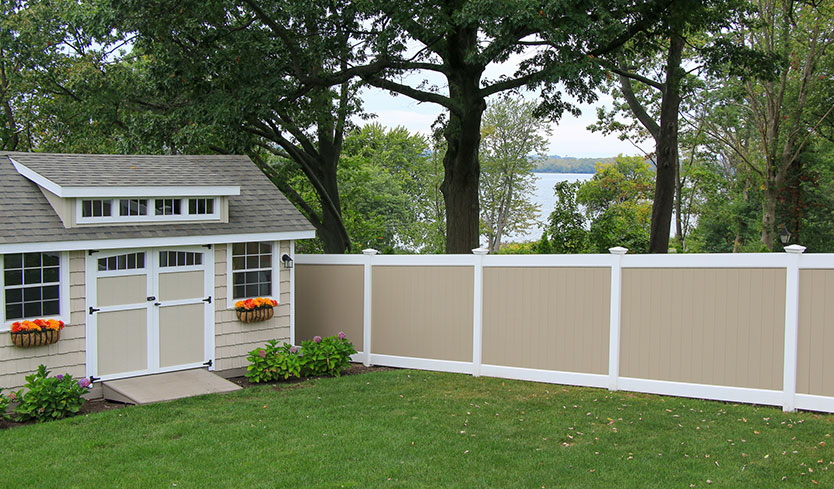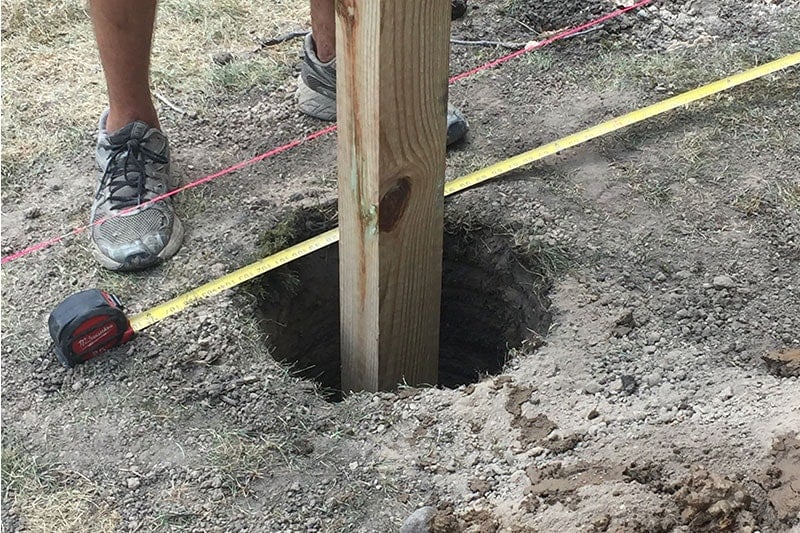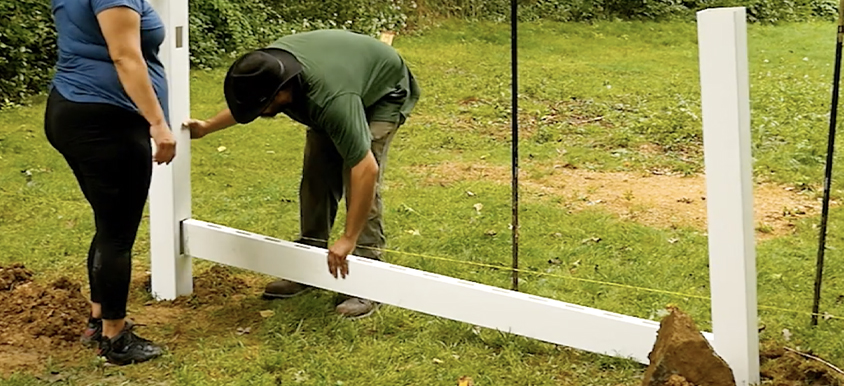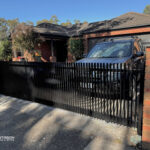Installing a vinyl fence can be a rewarding project that enhances the beauty and security of your property. Vinyl fencing is a popular choice for homeowners due to its durability, low maintenance, and aesthetic appeal. This comprehensive guide will walk you through the process of installing a vinyl fence, covering everything from planning and preparation to the final installation steps.

Why Choose Vinyl Fencing?
Before diving into the installation process, it’s important to understand why vinyl fencing is a preferred choice for many homeowners:
1. Durability and Low Maintenance: Vinyl fences are highly durable and resistant to weather, rot, and pests. They do not require painting or staining, making them virtually maintenance-free compared to other fence materials.
2. Long-lasting: Vinyl fences have a long lifespan and can withstand years of use without showing signs of wear or degradation. This makes them a cost-effective fencing solution in the long run.
3. Variety of Styles: Vinyl fences come in a wide range of styles, including privacy, picket, semi-private, and ranch rail. This variety allows property owners to choose a style that suits their aesthetic preferences and fulfills their functional needs.
4. Easy Installation: Vinyl fences are relatively easy to install, especially when compared to some traditional fencing materials. They often come in pre-assembled panels, which simplifies the installation process and saves time.
5. Fade Resistance: Vinyl fences are designed to resist fading caused by exposure to sunlight. They typically have UV inhibitors that help protect the material, ensuring that the fence maintains its appearance over time.
6. Environmentally Friendly: Vinyl fences are considered environmentally friendly because they are recyclable. Many manufacturers also use recycled materials in the production of vinyl fencing, reducing the impact on natural resources.
Overall, vinyl fences offer durability, low maintenance, a variety of styles, easy installation, fade resistance, and environmental friendliness. These qualities make vinyl fencing a popular choice for those seeking a long-lasting and visually appealing fencing solution.
Step-by-Step Guide to Install a Vinyl Fence

Planning Your Vinyl Fence Installation
Step 1: Check Local Regulations and Obtain Permits
Before you start installing your vinyl fence, check with your local zoning office to understand any regulations or restrictions that apply to fencing in your area. Some municipalities require permits for fence installation, and there may be specific guidelines regarding fence height, location, and materials.
Step 2: Measure Your Property

Accurate measurements are crucial for a successful fence installation. Use a measuring tape to determine the length of the fence line. Mark the boundaries with stakes and string to create a clear outline of where the fence will be installed.
Step 3: Choose Your Fence Style and Materials
Vinyl fences come in various styles, including privacy, picket, and ranch. Consider your needs and preferences when selecting the style of your fence. Additionally, make sure to purchase all necessary materials, including:
- Vinyl fence panels
- Posts
- Post caps
- Rails
- Concrete mix (for setting posts)
- Gate hardware (if you plan to install a gate)
Preparing for Installation
Step 4: Gather Tools and Supplies
Having the right tools on hand will make the installation process smoother. Here’s a list of essential tools and supplies you’ll need:
- Post hole digger or auger
- Level
- Tape measure
- String line and stakes
- Shovel
- Wheelbarrow
- Drill and bits
- Rubber mallet
- Safety gear (gloves, safety glasses)
Step 5: Dig Post Holes

The first step in the installation process is digging the post holes. The depth and width of the holes will depend on the height of your fence and local regulations. As a general rule, post holes should be one-third the length of the fence post and about twice the width.
- Use a post hole digger or auger to dig the holes.
- Make sure the holes are evenly spaced according to the length of your fence panels.
- To ensure stability, consider adding gravel to the bottom of each hole for drainage.
Installing the Fence Posts
Step 6: Set the Posts

Setting the posts correctly is crucial for the stability and longevity of your fence.
- Insert the Posts: Place a vinyl post into each hole. Use a level to ensure the posts are plumb (vertically straight).
- Add Concrete: Pour concrete mix into the hole around the post. Follow the manufacturer’s instructions for mixing and setting the concrete.
- Secure the Posts: Use a level to check the alignment of the posts as the concrete sets. Adjust as necessary to ensure the posts remain straight.
- Allow to Set: Let the concrete cure for at least 24 hours before proceeding with the installation.
Assembling the Fence Panels
Step 7: Install Bottom Rails

Once the posts are securely set, you can begin assembling the fence panels.
- Attach Brackets: Depending on your fence design, attach brackets to the posts to hold the bottom rails.
- Insert Bottom Rails: Slide the bottom rails into the brackets or slots in the posts. Ensure they are level.
Step 8: Install Fence Panels

With the bottom rails in place, you can now install the fence panels.
- Slide Panels into Rails: Slide the vinyl panels into the bottom rails. Depending on the design, the panels may snap into place or require screws for additional security.
- Check Alignment: As you install each panel, use a level to ensure it is straight and aligned with adjacent panels.
Step 9: Install Top Rails
After installing the panels, it’s time to secure them with the top rails.
- Attach Top Rails: Slide the top rails over the panels and secure them to the posts.
- Secure with Screws: If necessary, use screws to attach the top rails to the posts for added stability.
Installing the Gate
If your fence design includes a gate, follow these steps to install it:
Step 10: Install Gate Posts
Gate posts need extra reinforcement to support the weight and movement of the gate.
- Set Gate Posts: Follow the same process for setting regular posts but use additional concrete and ensure they are perfectly plumb.
- Reinforce Gate Posts: Consider adding metal inserts or additional bracing inside the gate posts for extra strength.
Step 11: Attach Gate Hardware
- Install Hinges: Attach the hinges to the gate and gate post. Ensure they are level and aligned.
- Attach Latch: Install the latch mechanism according to the manufacturer’s instructions.
Final Steps
Step 12: Install Post Caps
Post caps add a finishing touch to your vinyl fence and protect the posts from water and debris.
- Apply Adhesive: Apply a small amount of vinyl adhesive to the inside of each cap.
- Place Caps: Place the caps on top of each post and press down firmly.
Step 13: Clean Up
- Remove Debris: Clear away any debris, tools, and leftover materials from the installation site.
- Inspect the Fence: Walk along the fence line to ensure all panels and posts are securely in place.

Maintenance Tips for Your Vinyl Fence
One of the main advantages of a vinyl fence is its low maintenance requirements. However, a few simple steps can keep your fence looking new for years to come:
- Regular Cleaning: Use a garden hose to rinse off dirt and debris. For tougher stains, a mixture of soap and water and a soft brush can be used.
- Inspect for Damage: Periodically check your fence for any signs of damage or wear, such as cracks or loose panels.
- Avoid Harsh Chemicals: When cleaning your fence, avoid using harsh chemicals or abrasive cleaners that could damage the vinyl.
Troubleshooting Common Issues
Even with careful installation, you might encounter some issues with your vinyl fence. Here are a few common problems and solutions:
- Panel Sagging: If your panels start to sag, it could be due to loose screws or brackets. Tighten any loose hardware and check for proper alignment.
- Post Movement: If a post becomes loose, it may not have been set deeply enough or the concrete may have cracked. Re-dig the hole, add fresh concrete, and reset the post.
- Gate Alignment: If your gate starts to sag or doesn’t latch properly, check the hinges and latch for wear. Adjust or replace hardware as needed.
Conclusion
Installing a vinyl fence can enhance the beauty, privacy, and security of your property. By following this step-by-step guide, you can achieve professional results and enjoy the benefits of a durable, low-maintenance fence for years to come. Remember to plan carefully, take accurate measurements, and follow the manufacturer’s instructions for the best outcome. Happy fencing!
Feel free to browse our extensive range of fencing services on our website. We hope you found valuable information in this post. If you have any further questions, please don’t hesitate to contact us at 0424 204 857 or submit this request form.




